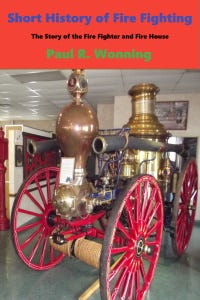Ancient Firefighting in the Greek and Roman World
The Romans Establish the First Fire Fighting Brigades
From the Book
Short History of Fire Fighting
Ancient Firefighting in the Greek and Roman World
Historical evidence indicates that the first firefighting equipment surfaced in the Egyptian city of Alexandria sometime in the Third Century BC. A Greek inventor named Ctesibius invented a water pump with which firefighters could spray water on a fire.
Ctesibius (C. 285 - 222 BC)
History knows little about Ctesibius' origins. Tradition holds that his father was a barber in Aspondia, a site near or in the Egyptian city of Alexandria. Tradition suggests that he took up his father's career early in life and invented a counterweight-adjustable mirror. His greatest reputation is as a mathematician, engineer and inventor. Historical lore suggests he was the founder of the Alexandrian school of mathematics and engineering and served as the head of the Museum of Alexandria. Inventions credited to Ctesibius include the water pump, water organ, an improved water clock and several types of automated machines. His force pump found use in pumping water from wells and as one of the first primitive fire fighting machines.
Firefighting did not become organized until the Romans began organizing fire brigades.
Roman Firefighting
Marcus Licinius Crassus (c. 115 BC or 112 BC – 6 May 53 BC), often called the "richest man in Rome," created the first known firefighting force. Fires were common in Rome, however the city had no organized firefighting force. Crassus started his own firefighting force by training about 500 of his slaves to fight fires. When a fire started, he would offer the owner of the building an exorbitantly low price for the property. If the owner accepted, Crassus had his slaves put out the fire. Crassus would then renovate the building and sell it a profit. If the owner refused, Crassus allowed the building to burn down.
Slave Fire Fighting Brigades
The Roman Emperor August established the first known permanent firefighting force in 6 AD. Augustus used elements from previous private firefighting brigades to form a military style firefighting brigade of 600 slaves to fight fires. He placed smaller units in fourteen strategic areas around the city in permanent camps. These forces had problems communicating with each other, so Augustus reorganized the brigades using freedmen to staff the brigades.
Vigils
Calling these men vigils, he had them based in the same fourteen districts and had the men patrol the streets, looking for fires. The vigils doubled as policemen as they had authority to arrest people breaking laws. The equipment they used included fire buckets (amae), sponges (spongiae), force-pumps (siphones), axes (dolabrae), picks (secures), ladders (scalae), grappling hooks (falces), quilted blankets (centones), wicker mats (formiones), poles (perticae), brooms (scopae) and vinegar.
From the Book
Short History of Fire Fighting
Discover the fascinating history of the firefighter, fire departments and fire towers when you read the Short History of Fire Fighting. The book includes historical information on fire engines, bunker gear and other equipment needed by a fire department. The book includes an extensive listing of firefighter museums in the United States as well as section on fire towers.
© 2023 Paul Wonning







Firefighting? Sounds dangerous. Let the slaves do it!